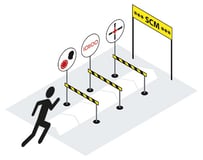How Technology is Reshaping Today’s Supply Chain
Nick Ostdick - June 22, 2017

 In today’s global, interconnected supply chain, the technology and software solutions a manufacturer deploys are just as important as a company’s supply logistics and management strategies. Because so many of the critical actions and decisions in the supply stream take place in a digital environment, the right technology can either propel a manufacturer toward robust growth and productivity or relegate them to a static position of efficiency. In short, identifying the right supply chain technology for a specific supply network model can be a make or break decision for companies competing on a global stage.
In today’s global, interconnected supply chain, the technology and software solutions a manufacturer deploys are just as important as a company’s supply logistics and management strategies. Because so many of the critical actions and decisions in the supply stream take place in a digital environment, the right technology can either propel a manufacturer toward robust growth and productivity or relegate them to a static position of efficiency. In short, identifying the right supply chain technology for a specific supply network model can be a make or break decision for companies competing on a global stage.
All this is to say technology is and will continue to be a truly disruptive force in how the modern supply chain is shaped, defined, and explored. Whether it was the use of spreadsheets and other manual data inputs in the 1990’s and early 2000’s, or the mass deployment of cloud technology and cognitive technology in more recent years, technology has time and time again reshaped the landscape of manufacturing and supply chain management. With this in mind, let’s examine a handful of ways technology is reshaping the supply chain of today.
Industry 4.0
When Henry Ford introduced the assembly line in 1913, he ushered in the second Industrial Revolution — and upended the automotive industry. Now a century later, thanks to the concept of Industry 4,0, the automotive industry is again making a dramatic shift. Industry 4.0 has been a boon to the automotive industry, streamlining operations and offering new business opportunities. Industry 4.0 is defined by connectedness: In the Industry 4.0-ready facility, devices connect to each other and to human interfaces, providing real-time data from myriad sensors. And humans can "connect" to that data at any time. Paired with advanced analytics and machine learning, this ecosystem of sensors, devices and humans is incredibly powerful.
Most automotive facilities haven't reached that perfect state of connectivity where humans and machines seamlessly work together. But the industry readily embraced the principles of Industry 4.0. At the same time, consumers have also been asking for greater connectivity with their automobiles, further pushing the industry to evolve. Today, most automotive manufacturers and suppliers have willingly started down the road to Industry 4.0, and the route is leading them to greater profitability.
Advanced analytics
Understanding advanced analytics as the ability to glimpse into the future to cut the complexities of the global supply chain is key to unlocking the value of this reporting model. Operating in two distinct categories: predictive (risk management, planning) and prescriptive analytics (transportation routes, inventory management). Advanced analytics removes much of the guesswork that was at one time associated with making informed decisions about demand planning and production programs.
With this fundamental understanding in-hand, it becomes easier for planners and managers to realize the benefits of advanced analytics and the ways in which advanced analytics can be deployed for enhanced productivity and efficiency.
Advanced analytics provide manufacturing companies with a number of distinct value propositions in terms of enhancing planning and production programs:
- Optimized planning capabilities: Applying advanced analytics to a demand planning strategy - in conjunction with other intelligent planning solutions like BOM management, Plan for Every Part, and Every Part Every Interval - allows planners and managers to optimize their planning platforms to ensure continuous production devoid of bottlenecks or breakdowns. In addition, advanced analytics gives manufacturers the necessary tools to respond and combat potential breakdowns via detailed ‘what-if’ scenarios and forecasting.
- Automated decision-making: The need to manage inventory levels and replenish certain component parts are prime candidates for automation through the application of advanced analytics. Job allocation, management of raw materials or resources, and job scheduling on the production floor are contexts in which advanced analytics gives planners more power and control over production programs. The monitoring, data gathering, reporting, and forecasting capabilities with advanced analytics make it more viable to allow for robotic platforms to execute these tasks with greater efficacy compared with human intervention.
- Support of the Lean-Agile model: For years now supply chain planners and managers have worked to create a supply model capable of responding to complex and often unforeseen variables in the procurement and manufacturing stages to ensure continued production and on-time delivery. This push for an agile supply stream, while critical, is simply not enough in today’s global supply network where the need to reduce or even eliminate redundancies is crucial for growth and productivity. Enter the idea of the lean supply chain where processes are streamlined and operational platforms are reimagined to encourage a quicker, more efficient movement of products across the value chain. The melding of these two supply management models has emerged in recent years as an important platform for manufacturing companies with multiple production facilities across the globe.
Postmodern ERP
To best define postmodern ERP, we must first briefly examine the history of ERP in general. The introduction of computer technology in the late 1960's and 1970's brought a fundamental shift to supply chain management. Activities that were once done manually could now be done by machine, and enthusiasm for automation swept the manufacturing industry. As software solutions became more readily available over the next two decades, supply chain managers increasingly adopted what's now known as the "best of breed approach."
But the new phase of ERP isn't a complete return to "best of breed." Instead, it's a hybrid of the modern ERP and the "best of breed" approach, taking the best parts of each. Postmodern ERP has recently emerged as an ideal strategy, blending the specialization available through "best of breed" with the consistency and strategic capacity of modern ERP. Postmodern ERP is like "best of both." This model uses a core ERP solution, bringing operation efficiency and business standardization. The core ERP is supplemented and complemented by specialized solutions, which are usually accessed either through the cloud or via business process outsourcers that can add value through innovation, differentiation and user-centered design.
The future of technology in the supply chain
What further complicates the way technology influences how manufacturing administer and oversee their supply streams is the sheer number of available technology platforms and software solutions automotive manufacturers have at their disposal. The volume of choice and variance between software solutions can be a significant pain point for planners and managers, especially as they search for the most effective technology with the greatest level of integrations and enhancements to leverage lean supply chain principles.
What does this mean for the future of technology in the supply chain? It means manufacturing companies will have to have a deeper understanding of how their supply pipeline functions and the needs and necessary integrations required of their technology solutions. No longer will it be viable to simply deploy the technology flavor of the week. Rather, manufacturing companies must strive for greater insight into their overall supply situation and how to successfully position the right products in front of the right customer at the right time.
LATEST POSTS
- Understand Circular Economy in The Manufacturing Industry
- How Can Industry 4.0 IT Integration Be Achieved Smoothly?
- The Significance of Order Sequencing in Discrete Manufacturing
- How to improve your Supply Chain Management: The Power of Control Towers
- Optimizing Human Resource Scheduling in Manufacturing: A Technological Approach



